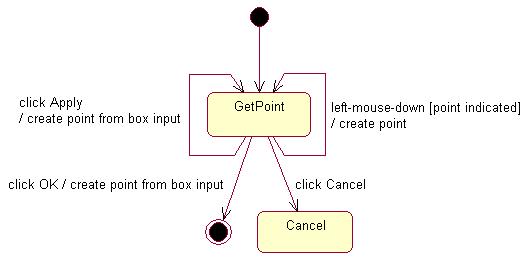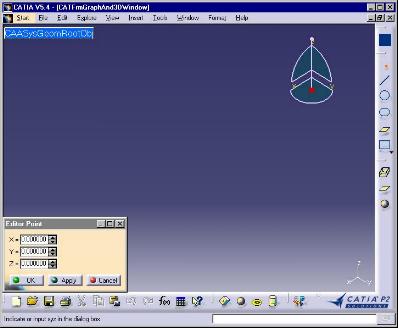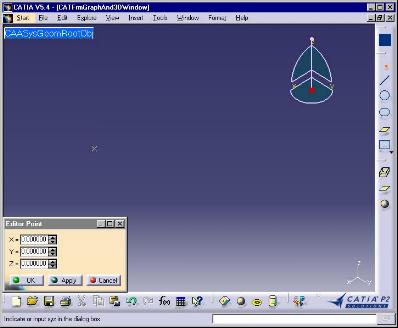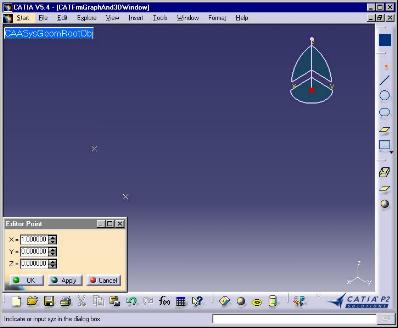
3D PLM Enterprise Architecture |
User Interface - Commands |
Associating a Dialog Box with a StateUsing a dialog box to input data and to trigger several transition from a state |
| Use Case | ||
AbstractThis article shows how to use a Dialog box associated with a state in a state dialog command. |
This use case is intended to show how to use a dialog box associated with a state in a dialog command. This dialog box is used to input precise values rather than indicating a point on the screen. In addition, you will learn how to use the Cancel state.
[Top]
The Point command is a use case of the CAADialogEngine.edu framework that illustrates the DialogEngine framework capabilities.
[Top]
The Point command is a state dialog command that creates a point in the 3D space according to the following UML statechart diagram [1].

The dialog is as follows:
 |
Select the Point command. The active state becomes GetPoint, and the dialog box is displayed. You can either indicate a point or use the dialog box. |
 |
Click to indicate a point. The transition loops to GetPoint and creates the point. You can click another point or use the dialog box. |
 |
Enter values in the dialog box spinners. Clicking Apply create the point whose coordinates were entered and you can again either click to indicate a point or use the dialog box. This is what's shown beside. Clicking OK creates the point and ends the command. Clicking Cancel doesn't create the point and ends the command. |
Indicating a point [2] means clicking on the screen at the desired location with the left mouse key. This is a very handy way, but sometimes it is not accurate enough, and a dialog box in which numerical values can be entered is often needed. The Point command enables both indication and dialog box input. Only the latter is described here.
[Top]
See the section entitled "How to Launch the CAAGeometry Use Case" in the "The CAAGeometry Sample" use case for a detailed description of how this use case should be launched [3].
Then, in the window where you run the mkrun command, do not type the module name on the command line, but type CNEXT instead. When the application is ready, do the following:
[Top]
The Point command is made of a single class named CAADegCreatePointCmd located in the CAADegGeoCommands.m module of the CAADialogEngine.edu framework:
| Windows | InstallRootDirectory\CAADialogEngine.edu\CAADegGeoCommands.m\ |
| Unix | InstallRootDirectory/CAADialogEngine.edu/CAADegGeoCommands.m/ |
where InstallRootDirectory is the directory where the CAA CD-ROM
is installed.
[Top]
To create the Point command, there are three steps:
| # | Step | Where |
|---|---|---|
| 1 | Create the Point Command Class Header File | Header file |
| 2 | Implement the Statechart Diagram | BuildGraph method [4] |
| 3 | Releasing the Indication Agent and the Dialog Box | Destructor |
[Top]
The CAADegCreatePointCmd state command class derives from CATStateCommand.
...
class CAADegCreatePointCmd : public CATStateCommand
{
CmdDeclareResourceFile(CAADegFileCmd,CAADegCreatePointCmd,CATStateCommand);
public :
CAADegCreatePointCmd();
virtual ~CAADegCreatePointCmd();
...
virtual void BuildGraph() ; // Implements the statechart
CATBoolean CheckPoint(void * iData); // Checks if the point can be created
CATBoolean CreatePointByIndication(void * iData);
CATBoolean CreatePointByBox (void * iData);
private :
CATIndicationAgent * _daIndication; // Indication agent
CAADegPointEditor * _PointEditor; // Dialog box
void NewPoint(const CATMathPoint &iPoint); // Action method to create a point
...
|
This header file includes:
CmdDeclareResource macro states that the resources of the
CAADegCreatePointCmd command are located in the CAADegFileCmd.CATNls
file. If resources were assigned to the CATStateCommand class, they would be
concatenated with the resources for CAADegCreatePointCmdBuildGraph method implements the statechart diagramCreatePointByIndication
or CreatePointByBox respectively[Top]
This is done in the command BuildGraph method.
void CAADegCreatePointCmd::BuildGraph()
{
//1- Creates the indication agent
_daIndication = new CATIndicationAgent("Indication");
...
|
The indication agent is instantiated. The default projection plane is used; it is a plane parallel to the screen plane
Then, the dialog box is instantiated and built. It is an instance of the CAADegPointEditor class that derives from the CATDlgDialog class and that simply includes a spinner for each coordinate, and three push buttons OK, Apply, and Cancel.
...
//2- Creates the dialog box to input xyz
CATApplicationFrame * pFrame = NULL ;
CATDialog * pParent = NULL ;
pFrame = CATApplicationFrame::GetFrame() ;
if ( NULL != pFrame )
{
pParent = pFrame->GetMainWindow() ;
}
_PointEditor = new CAADegPointEditor(pParent);
_PointEditor->Build();
...
|
The parent of this dialog box is an invisible dialog object which contains
all the windows of the same document. This object is returned by the GetMainWindow
method on the application frame. Refer to the article entitled
"Understanding the Application Frame Layout" [5]
for complete details about this object.
Dialog boxes should always be instantiated without controls (or other dialog
objects). Instantiating these controls in a Build method called
after the constructor has returned make sure that the control resources will be
correctly allocated.
The GetPoint state is an instance of the CATPanelState class, dedicated to states associated with a dialog box.
... //3- Creates the state associated with the dialog box and containing the // Indication Agent CATPanelState * stState = new CATPanelState(this, "GetPointId", _PointEditor); SetInitialState(stState); stState->AddDialogAgent(_daIndication); ... |
The state is also a CATCommand instance and must be assigned a parent
in the command tree structure. This parent is set as this in the
first constructor argument, that is, as the state dialog command itself. A
pointer to the dialog box is passed as the third argument to associate the
dialog box with the state. Since the state is explicitly constructed, it must be
added as a the command initial state using SetInitialState.
Usually, this is GetInitialState that instantiates and sets the
state as the initial state.
Then the transition that loops on this state when the end user indicates a point is defined as follows.
...
//4-Defines the transition triggered by the Indication Agent
CATDialogTransition *pFirstTransition = AddTransition(
stState,
stState,
AndCondition(IsOutputSetCondition(_daIndication),
Condition((ConditionMethod)&CAADegCreatePointCmd::CheckPoint)),
Action((ActionMethod) & CAADegCreatePointCmd::CreatePointByIndication)
); |
The AddTransition method creates a transition and adds it to the
transitions managed by the dialog command. Pointers to the transition's source
and target states are the first and second arguments respectively. This self
transition goes from/to the same GetPoint state. The transition trigger is
defined in the guard condition as the first condition to be checked using the IsOutputSetCondition
method applied to the indication agent. A second condition uses the CheckPoint
method. Because we use AndCondition to create the guard condition,
both condition methods must return True to fire the transition. In this case,
the CreatePointByIndication action method is executed.
The CATPanelState class creates automatically transitions depending on the style of the associated Dialog box:
The Apply and Ok transitions are retrieved from the state and assigned a condition and an action.
... //5- Completes the Apply transition // Sets a condition to the Apply transition (stState->GetApplyTransition())->SetCondition(Condition((ConditionMethod)&CAADegCreatePointCmd::CheckPoint)); // Sets an action to the Apply transition (stState->GetApplyTransition())->SetAction(Action((ActionMethod)&CAADegCreatePointCmd::CreatePointByBox)); //6- Completes the Ok transition // Sets a condition to the Ok transition (stState->GetOkTransition())->SetCondition(Condition((ConditionMethod)&CAADegCreatePointCmd::CheckPoint)); // Sets an action to the Ok transition (stState->GetOkTransition())->SetAction(Action((ActionMethod)&CAADegCreatePointCmd::CreatePointByBox)); ... } |
Don't forget to release the state before getting out of scope.
... // As the state was created explicitly by "new" instead of the // GetInitialState method, it must be released. stState->Release(); } |
[Top]
A pointer to the indication agent was created in the command BuildGraph
method as a data member to be accessed and used in different methods. It should
be released when it becomes useless. This can be done in the command destructor,
as shown here. This could also be done in the Cancel method called
just before the destructor. In the same way, the dialog box should be destructed
as soon as possible. This is possible using the RequestDelayedDestruction
method.
CAADegCreatePointCmd::~CAADegCreatePointCmd()
{
if (NULL != _daIndication) _daIndication->RequestDelayedDestruction();
daIndication = NULL ;
if (NULL !=_PointEditor) _PointEditor->RequestDelayedDestruction();
_PointEditor = NULL ;
...
|
[Top]
This use case shows the objects involved when a dialog box is used in
conjunction with a specific state dedicated to it (the "panel" state):
the state dialog command, the statechart and its implementation in the BuildGraph
method, the "panel" state, and the specific way to assign condition
and action methods to transitions triggered when pressing the dialog box push
buttons.
[Top]
| [1] | Describing State Dialog Commands Using UML |
| [2] | Managing Indication |
| [3] | The CAAGeometry Sample |
| [4] | Implementing the Command Statechart Diagram |
| [5] | Understanding the Application Frame Layout |
| [Top] | |
| Version: 1 [Jan 2000] | Document created |
| [Top] | |
Copyright © 2000, Dassault Systèmes. All rights reserved.